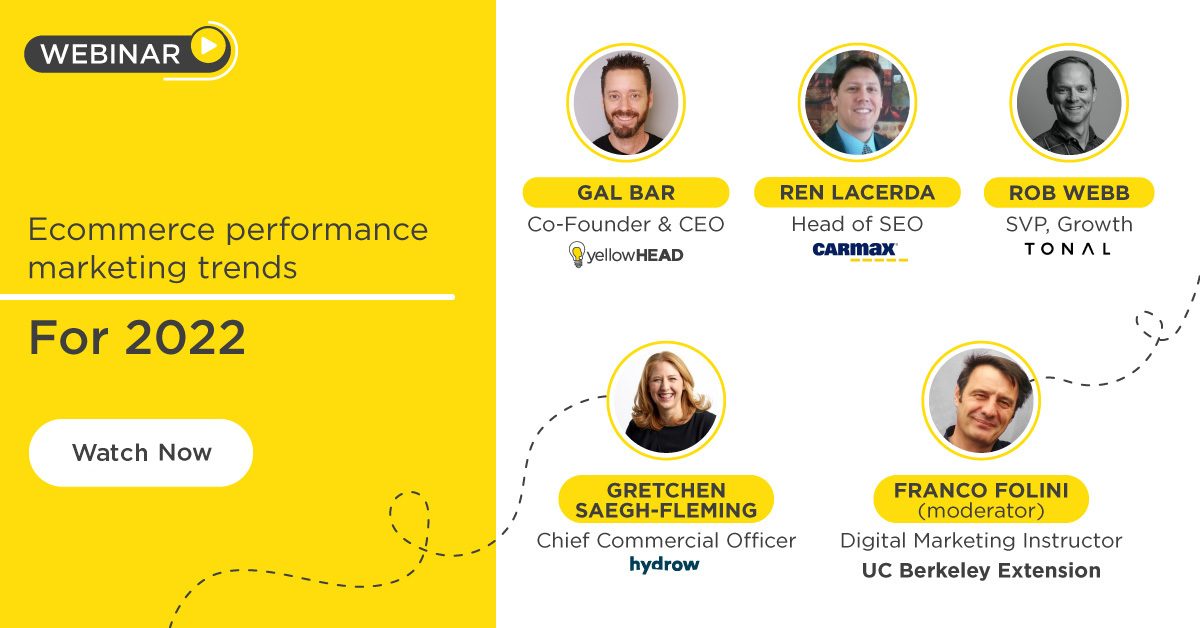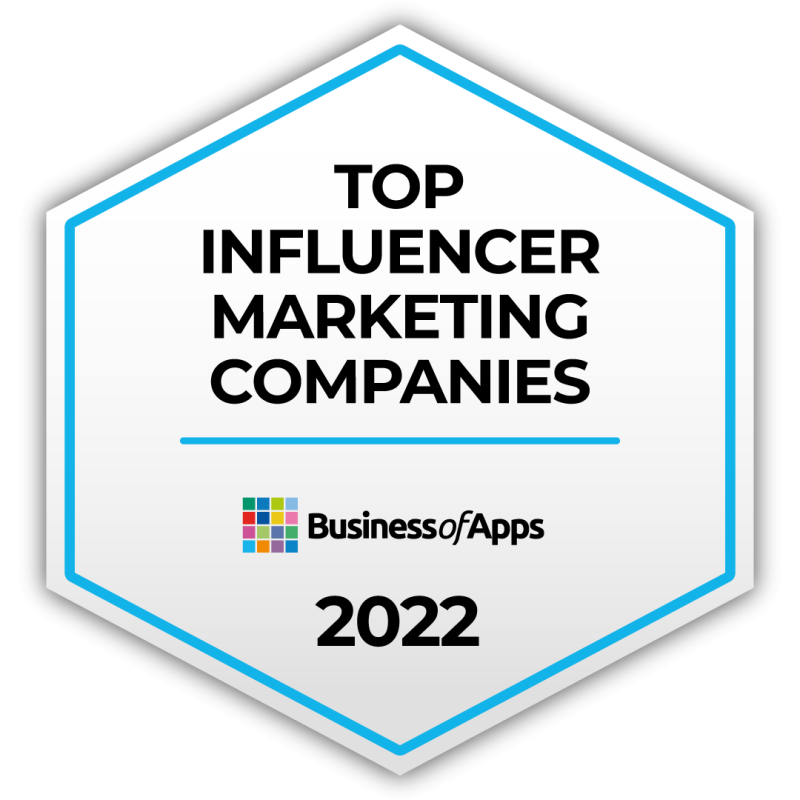Webinar Recap: How eCommerce Performance Marketing Will Change in 2022
From privacy lockdowns to social commerce integrations, 2022 will be a whirlwind for eCommerce marketers.

Performance marketers constantly adapt to change, but the past few years have been especially complex. Cookies are dying, privacy restrictions are rising, and the entire media landscape is changing in response to COVID-19. That’s why it’s important to take a step back and consider how these trends will continue to evolve in 2022.
To that end, VentureBeat and yellowHEAD recently hosted an eCommerce marketing trends webinar to explore what may come next. Our guests included:
- Moderator: Franco Folini Digital Marketing Instructor, UC Berkeley Extension
- Gretchen Saegh-Fleming Chief Commercial Officer, Hydrow
- Rob Webb SVP, Growth, Tonal
- Ren Lacerda Head of SEO, CarMax
- Gal Bar Co-Founder & CEO, yellowHEAD
You can view the full webinar below or read our summary. Let’s get started!
Jump to a section…
The Privacy Trend is Not a Blip
COVID is Changing Social Media Demographics
Consumers Will Shop Via Social Media
Organic Traffic > Paid Marketing Costs
Let Customers Promote Your Brand
The Privacy Trend Is Not a Blip
Of course, there’s no way to talk about 2022 trends without discussing privacy. Even outside of Apple’s iOS changes, the industry faces new government regulations and a consumer base deeply concerned about how brands track online activity.
“Our view is that it’s certainly not a blip. It’s going to be a trend that doesn’t go away and increases and intensifies, so we should all prepare for more privacy lockdowns,” Rob says. “As a consumer, I personally hope it continues! As a marketer, it does make the landscape we’re working on complex.”
Thankfully, these privacy changes do not mean marketers lack opportunities — just that companies who deeply understand their market will have the advantage. That bodes well for direct-to-consumer eCommerce brands in the immediate future, but companies with an old-school mentality will find it much more challenging to keep up with the latest trends.
In Gal’s view, the companies that are best positioned to succeed in a privacy-centric world are diversifying budgets across platforms. He says, “If we saw more Google and Facebook in the past, now we see more diversification of budgets towards TikTok and Snap as well.” eCommerce brands are also leaning into organic marketing, understanding it as a high-value evergreen channel. “If they have an app, they invest much more in the app store optimization and, [if they’re running on] web, they invest much more in the SEO strategy…And, obviously, the creative is always at the core of everything our clients are doing. Creative has a huge investment going forward as well,” Gal explains.
COVID Is Changing Social Media Demographics
In the wake of COVID-19, social media user demographics are undergoing a seismic shift. Before the pandemic, most audiences favored one or two primary channels. When lockdowns occurred, many users branched out to follow multiple platforms. A user who started with Facebook or Instagram now has both, along with new TikTok and Snapchat profiles. As Gal notes, “It’s really interesting how COVID urged the maturity or the aging of the platforms themselves. If TikTok was considered a very young, early adopter platform, now over 70% of the users are over 18.” Across the board, social media audiences are aging as a result of this uptick in adoption.
For eCommerce brands, this trend makes it difficult to target a single social media platform and confidently reach the majority of their audience. In response, marketers are diversifying their ad spend to acquire customers across multiple channels. Most brands now have a presence across each social media platform, maintaining several possible touchpoints for consumers.
While these changes lead to new brand opportunities, marketers face unique challenges — most notably the need to produce additional creative for each channel. “You really need to be creating content as a brand that feels native to the platform,” Gretchen says. “If you show up with a traditional television ad on TikTok, it’s not going to land.”
Consumers Will Shop Via Social Media
Thanks to COVID-19, more shoppers are using eCommerce than ever before. However, the truly disruptive impact isn’t the arrival of new customers — it’s the impact on consumer behavior. “Consumers became so much more demanding in terms of ease-of-use, clean user interface, lack of friction, high-touch service environments, and really the ability to do almost everything you would have done in a brick and mortar environment online,” Gretchen explained.
Since 2021 suggests there will be no clear post-COVID landscape for some time, brands that continue to invest in experiential content will have an advantage. One example of this trend is already visible in social commerce. Consumers spend more time on social media to interact with friends and family, and many want to shop directly from the platform. “Customers don’t like to stop in the middle of the funnel to go to another website; it causes a lack of trust,” Gal said. As a result, he predicts that full shopping integration with social media will be a big part of the 2022 eCommerce experience.
Organic Traffic > Paid Marketing Costs
Paid marketing costs are up across the board, increasing by over 47% in some cases. As a result, marketers will go into 2022 needing to be as capital efficient as possible. In an environment where tracking options are limited, that makes it all the more critical for eCommerce brands to drive organic traffic — whether using SEO or accounting for social media platform algorithms.
However, keeping on top of SEO practices in 2022 is no easy task. Ren explains that SEO is not just about making keyword changes — the AI behind it is complex, dynamic, and constantly evolving. On top of that, eCommerce marketers often find themselves catering to platform algorithms instead of engaging customers.
“[You’re] serving an algorithm on top of your customers,” he says. “So you have to create experiences that satisfy the algorithms so [customers can see and enjoy them]. A lot of the time, these two things are in conflict. It’s a big challenge.”
To grow in this environment, most brands need to change their business practices alongside their marketing strategy — it’s not enough to churn out keywords for SEO traffic. “Instead of ad money, you need brainpower and the ability to execute faster,” Ren says. The good news is once you have that SEO ranking, it represents long-lasting value that will be easier to maintain.
Let Customers Promote Your Brand
Social commerce isn’t just about finding new revenue channels; it’s also about generating organic traffic. In 2022, Gretchen believes most brands will use social posts to sell products and mobilize brand advocates — the customers willing to promote a brand. Many platforms host entire communities that gladly post about shopping experiences, share promotions, and express their appreciation for D2C businesses with no brand input.
To capture these opportunities, businesses will need to rethink the scale of community management. For example, 1:1 interactions on a comments page will be visible to everyone, generating goodwill if you show appreciation for customers during a support conversation. D2C businesses also have many opportunities to leverage user-generated content about a brand when they give users the resources to create them.
“Our role and opportunity as brand custodians is to enable experiences and support touchpoints,” Gretchen said. “One of the ways we’ve seen success is by leveraging content created by our members or influencers and putting some paid [ad spend] behind that.” This strategy boosts the visibility of user-generated content, embedding it in the conversation until organic traffic takes over.
These discussion points only scratch the surface of our discussion on eCommerce trends, so don’t forget to watch the entire webinar! The yellowHEAD team would like to thank Gretchen, Rob, Ren, and Franco for joining Gal for an in-depth, fascinating discussion about the future of e-commerce marketing.
Remember: If you’re looking to develop a winning eCommerce marketing strategy, we’re ready to help!



















